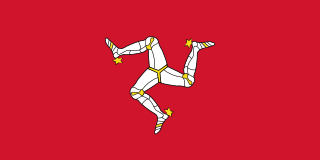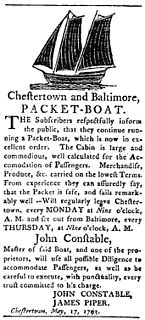
HMS Egret was a sloop of the British Royal Navy, the lead ship of her class. She was built by J. Samuel White at Cowes, Isle of Wight, was launched on 31 May 1938, and is notable for being the first ship sunk by a guided missile in combat. So far she is the only Royal Navy warship to be named Egret.
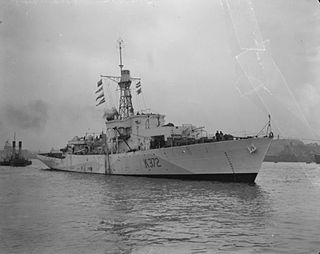
HMS Rushen Castle (K372) was a Castle-class corvette of the United Kingdom's Royal Navy. She was named after Castle Rushen in Castletown, Isle of Man.
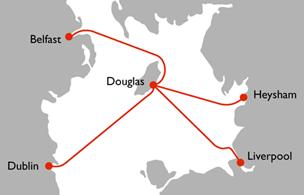
The Isle of Man Steam Packet Company Limited is the oldest continuously operating passenger shipping company in the world, celebrating its 180th anniversary in 2010.

HMS Wellington is a Grimsby-class sloop, formerly of the Royal Navy. During the Second World War, she served as a convoy escort ship in the North Atlantic. She is now moored alongside the Victoria Embankment, at Temple Pier, on the River Thames in London, England, as the headquarters ship of the Honourable Company of Master Mariners, where she is known as HQSWellington. It was always the ambition of the founding members of the company to have a livery hall. Up to the outbreak of war in 1939, various proposals were examined, including the purchase of a sailing ship, Archibald Russell.
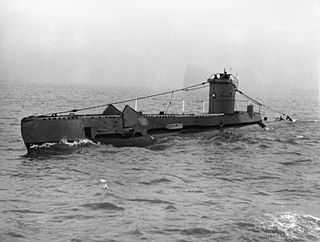
HMS Upstart (P65) was a Royal Navy U-class submarine built by Vickers-Armstrong. So far she has been the only ship of the Royal Navy to bear the name Upstart. After the war, she was loaned to the Greek Navy and renamed Amfitriti.
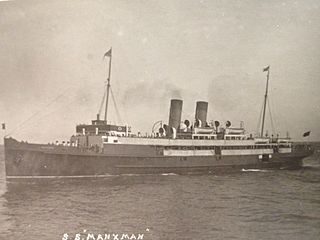
TSS Manxman was a turbine steamer launched in 1904 for the Midland Railway and operated between Heysham and Douglas, Isle of Man. In 1916, she was commissioned by the Royal Navy as HMS Manxman and saw action as a seaplane carrier during the First World War, after which she was acquired by the Isle of Man Steam Packet Company. On the outbreak of the Second World War she was again requisitioned as a troop ship, until she was commissioned and her name changed to HMS Caduceus. She never returned to Manx waters, and was scrapped in August 1949.
Two ships of the Royal Navy have borne the name HMS Manxman, after the term for an inhabitant of the Isle of Man:
William Kennish, was a poet, engineer, explorer, scientist, and inventor. He acted as guide for an American Navy and Army led expedition approved by Congress to verify his Atrato-Truando river interoceanic canal route which linked the Pacific to the atlantic oceans in 1855.
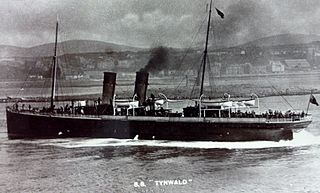
SS (RMS) Tynwald (III), No. 95755, was an iron passenger steamer which served with the Isle of Man Steam Packet Company, and was the third vessel in the Company to bear the name.
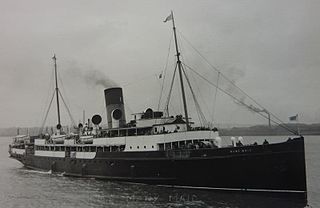
TSS (RMS) Manx Maid (I) No. 131765 - the first ship in the Company's history to be so named - was a packet steamer which was bought by the Isle of Man Steam Packet Company from the London and Southwestern Railway Company, and commenced service with the Steam Packet in 1923.

HMS Elfin was a torpedo recovery vessel built for the Royal Navy. She was built by J. Samuel White & Company, East Cowes, Isle of Wight, was launched on 20 November 1933 and commissioned on 16 January 1934. She was builder's number 1754. Her home port was the Navy's torpedo trials establishment HMS Vernon, and she was based at Portland. A sistership, Redwing, was constructed under builder's number 1753 and was stationed at HMS Defiance, Devonport. Elfin was renamed Nettle during the Second World War, and was later sold for scrapping. She survived in mercantile service, and has been preserved.

HMS Hotham (K583) was a Captain-class frigate of the Buckley class of destroyer escort, originally intended for the United States Navy. Before she was finished in 1944, she was transferred to the Royal Navy under the terms of Lend-Lease, and was in commission from 1944 to 1956, including service during World War II.

HMS Vesper was a V-class destroyer of the British Royal Navy that saw service in World War I and World War II.

HMS Winchester was an Admiralty W-class destroyer of the Royal Navy. She saw service in the First and Second World Wars.

SS (RMS) Mona's Isle (IV) was a steel, triple-screw turbine driven packet steamer operated by the Isle of Man Steam Packet Company between 1920 and 1948. Built in 1905 for the South Eastern & Chatham Railway Company, she was operated as Onward between Folkestone and Boulogne. In 1918 a fire was only controlled by scuttling the vessel. She was righted and in 1920, the hull was purchased by IOMSPCo to replace tonnage lost during the war. She was the first ship to complete a round trip during the evacuation of Dunkirk, rescuing a total of 2,634 troops.

HMS Vectis (D51) was a V-class destroyer of the British Royal Navy that saw service in World War I and the Russian Civil War.

The third HMS Windsor (D42) was a W-class destroyer of the British Royal Navy that saw service in the final months of World War I and in World War II.

The Battle of Bishops Court, also known as The Defeat of Thurot, was a naval engagement that took place 28 February 1760, during the Seven Years' War, between three British ships and three French ships. The French force under famed commander François Thurot were brought to battle in the Irish sea between the Isle of Man and the coast of Ireland at 9 am. After a close-fought action, Thurot's force was battered into submission, with his ships dismasted and reduced to a sinking condition. Thurot was shot through the heart and died during the action. The British took all three French ships, completing victory.
John Charles Keith "Jack" Dowding (1891–1965) was a British naval officer during the 20th century. He served in both world wars and was awarded the DSO for his actions during the Dunkirk evacuation. He is best known for being the commodore in charge of the ill-fated Arctic convoy PQ 17.

